 |
|
|
|
|
|
|
|
|
|
|
|
||
|
|
|
||
May 1998
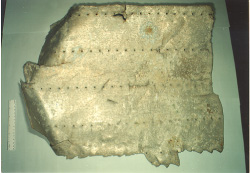 Recently
analyzed photographic evidence indicates that the section of aluminum aircraft
skin we found on Nikumaroro in 1991 (Artifact 2-2-V-1) does not come from
the part of the Earhart aircraft where we had suspected it did.
Recently
analyzed photographic evidence indicates that the section of aluminum aircraft
skin we found on Nikumaroro in 1991 (Artifact 2-2-V-1) does not come from
the part of the Earhart aircraft where we had suspected it did.
The aluminum sheet, while undoubtedly a section of airplane skin, does not seem to fit any known aircraft type, including the Lockheed Electra. However, the general construction of the piece (type of aluminum, thickness, rivet type, rivet size, space between rivets, rate of taper between rivet lines, etc.) seems to be more typical of the Lockheed 10 than of the WWII types used in the Central Pacific. There is no doubt that, following the extensive repairs necessitated by the Hawaii wreck which ended the first world flight attempt, Earhart’s airplane differed in some respects from standard Electra’s. It was, and still is, our hypothesis that Artifact 2-2-V-1 is from one of those repaired, non-standard areas. But, like trying to fit an errant piece into a jigsaw puzzle, we haven’t yet found just where and how it fits.
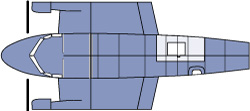 Our
first candidate for a point of origin was an area under the aft cabin. The
match seemed pretty good: .032 Alclad aluminum, four rows of AN455 AD 3/3
rivets converging at a rate of ¼ inch over the length of the sheet,
a bordering line of #5 rivets, no crossing line of rivets, even a failure
pattern that suggested that the sheet tore around an antenna mast that was
on Earhart’s
Electra. The fit wasn’t perfect. The rivet pitch (space between individual
rivets) was 1 inch on the artifact rather than the 1.5 inches on the airplane,
and the space between lines of rivets was an inch or less narrower on the
artifact than on the airplane. Still, the match was far closer than we had
seen on any other type of aircraft and we thought those variations might
not be unreasonable on an airplane as extensively repaired as Earhart’s.
Our critics disagreed –
vehemently. They pointed out that the distances between the lines of rivets
are dictated by the airplane’s stringers, which are not likely to
change. And the antenna wasn’t where we had thought it was. No cigar.
Our
first candidate for a point of origin was an area under the aft cabin. The
match seemed pretty good: .032 Alclad aluminum, four rows of AN455 AD 3/3
rivets converging at a rate of ¼ inch over the length of the sheet,
a bordering line of #5 rivets, no crossing line of rivets, even a failure
pattern that suggested that the sheet tore around an antenna mast that was
on Earhart’s
Electra. The fit wasn’t perfect. The rivet pitch (space between individual
rivets) was 1 inch on the artifact rather than the 1.5 inches on the airplane,
and the space between lines of rivets was an inch or less narrower on the
artifact than on the airplane. Still, the match was far closer than we had
seen on any other type of aircraft and we thought those variations might
not be unreasonable on an airplane as extensively repaired as Earhart’s.
Our critics disagreed –
vehemently. They pointed out that the distances between the lines of rivets
are dictated by the airplane’s stringers, which are not likely to
change. And the antenna wasn’t where we had thought it was. No cigar.
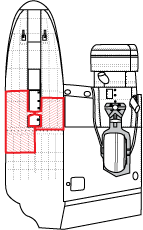 Our
next possibility was farther forward on the belly. As detailed in “Finding
A Fit” (TIGHAR Tracks Vol.
12, Nos 2 & 3), we had reasoned that
the torn sheet of metal “may be from a repair patch installed on the
underside of the Earhart aircraft on the left hand (pilot’s) side
of the airplane just forward of the main beam (wing spar).” Lockheed
repair orders called for the metal sheet in that area (Skin 25L) not to
be completely replaced – “rivet
new skin in place with a double row of rivets similar to joint in slanting
bulkhead.”
If the ordered repair had been carried out using .032 rather than the .040
Alclad, and if two stiffeners had been added to compensate for the slightly
thinner metal (a not-unreasonable possibility), we would have something that
looked exactly like 2-2-V-1.
Our
next possibility was farther forward on the belly. As detailed in “Finding
A Fit” (TIGHAR Tracks Vol.
12, Nos 2 & 3), we had reasoned that
the torn sheet of metal “may be from a repair patch installed on the
underside of the Earhart aircraft on the left hand (pilot’s) side
of the airplane just forward of the main beam (wing spar).” Lockheed
repair orders called for the metal sheet in that area (Skin 25L) not to
be completely replaced – “rivet
new skin in place with a double row of rivets similar to joint in slanting
bulkhead.”
If the ordered repair had been carried out using .032 rather than the .040
Alclad, and if two stiffeners had been added to compensate for the slightly
thinner metal (a not-unreasonable possibility), we would have something that
looked exactly like 2-2-V-1.
It was an elegant hypothesis, but to test it we needed a good photo of the suspect part of the belly taken after the repairs. Such a picture proved very difficult to come by, but after an exhaustive search Mike Firczuk (TIGHAR #2002) found a pair of photos taken at San Juan, Puerto Rico on June 3, 1937 which had just the right angle and sufficient resolution to give us a look. Mike managed to borrow original prints from an archive and our friend Jeff Glickman at Photek in Hood River, Oregon digitized and enhanced the photos, allowing us to see if the rivet lines we had theorized might be there were, in fact, present. They weren’t. What’s more, there appears to be at least one structure present which should show up on the artifact, but doesn’t. But what is really puzzling is that the patch specified in the repair orders doesn’t seem to be there either. There should be “a double row of rivets similar to joint in slanting bulkhead” 9½ inches aft of the slanting bulkhead and there is quite obviously no such seam present. It would appear that whatever repairs were made to NR16020 following the wreck at Luke Field, they did not conform entirely to the repair orders issued by Lockheed. That presents something of a quandary in trying to assess whether Artifact 2-2-V-1 could reasonably be part of the Earhart aircraft. In the absence of photos taken by someone lying on their back under the airplane, no one can say with any certainty just what the rest of the belly looked like, regardless of what the repair orders call for. So where did this battered bit of aluminum come from? Further research may or may not provide a conclusive answer, but we’ll keep at it.
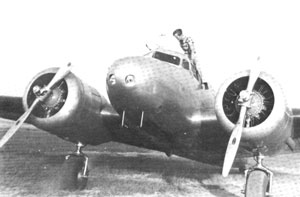
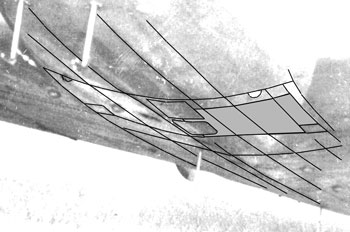
This is what the belly should look like if the repairs were carried out as specified in the Repair Orders. (Rivet lines shown as solid lines. Patch shown in gray.)
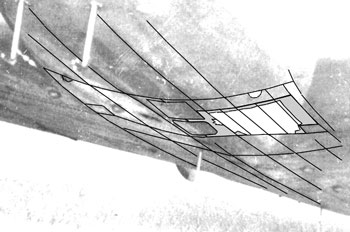
This is what the belly should look like if the patch was installed as theorized by TIGHAR. (2-2-V-1 is shown in white against gray patch.)
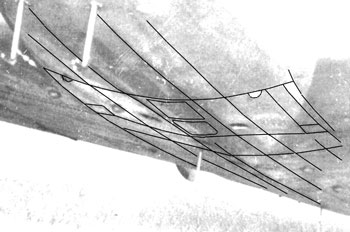
This is what the belly actually looked like as determined from the San Juan photos.
